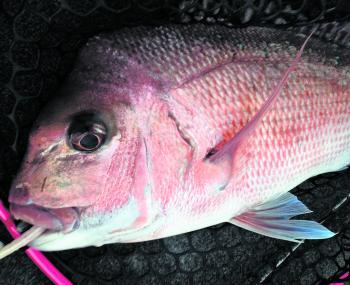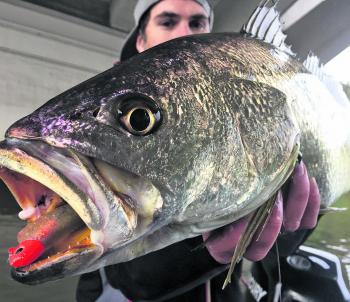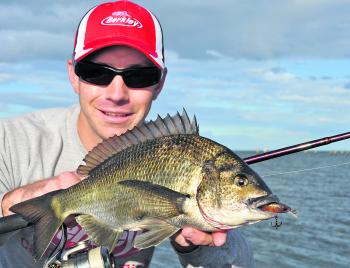A burst of above average spring weather has kicked the inner reefs into gear with the snapper firing on all cylinders across the western flank of Port Phillip. Additionally, some serious blue spot flathead have been lurking in the shallows, and with Australian salmon and snook lurking nearby, it can be a real mixed bag for those prospecting the inner reefs at this time of year. So, whether you’re a complete novice, a casual weekender or a more accomplished angler with years of experience, now is the time to be on the water.
Chasing snapper on soft plastics is fairly common practice these days. Indeed, it’s been on the radar for more than a decade now, but recently I’ve had a few enquiries from readers in relation to gear and how to get started. Tackling up for snapper on soft plastics is a compromise between presentation and power. Simply tying a jig-head onto a traditional 6-8kg baitfishing outfit spooled with 20lb plus monofilament definitely won’t cut it. In order to maximise casting distance and bring a plastic to life underwater, a crisp 4-6kg graphite spinning rod up to about 7ft in length matched to a medium size thread line reel is the way to go.
Next, fill the spool with say 10lb braid and tie on 12-15lb leader. While this gear is relatively light in comparison to most standard baitfishing outfits, it is more than capable of playing out a big red in snag-less open water. Small to medium size snapper can even be subdued on line class half this strength, particularly when fishing under electric power on the drift. In this situation, chasing the fish down, as opposed to cranking them back to a boat at anchor, is a viable option. Thinner mainlines add meters to your casting, which is vital when fishing the shallow reefs. Fine leaders also increase your hook up rate, especially in clear conditions, though extra insurance is required around heavy structure or when larger snapper are expected.
The ability to rig a soft plastic correctly on a weighted jig-head is crucial and this can be practiced and perfected at home. Always ensure a plastic is rigged straight and centred neatly on the jig-head. Take the time to measure the head up against the hook to determine exactly where the point should exit. Avoid bunching the plastic up against the jig-head or stretching it to fit over the hook. If it doesn’t look perfect, rig it again until you get it right. Once you’re happy with the way it sits, test whether the tail swims straight (i.e. does not spiral or track to one side), both when dragged through the water and while falling freely to the bottom. Next month we’ll look at some on water tactics to hopefully help you connect to a snapper on a soft plastic.
Soft plastics have been producing some good eating size flatties to 50cm throughout Corio Bay outer harbour, at Clifton Springs, Avalon and Point Wilson. Closer to Point Henry and surrounds, the local commercial netters have been giving the area a hammering of late with a number of anglers frustrated by the dislodged floating weed and apparent lack of fish! Over at Werribee South, expect the shallows through to Campbells Cove to hold increasing numbers of flathead and some good gummy sharks this month. On the reefs at Point Cook, November traditionally sees a run of 3kg+ reds venturing into some very skinny water of just 3-5m in depth. These fish are prime candidates for a well presented soft plastic.
Reds to 6kg+ have been taken in close at Williamstown, especially at first and last light. Soft plastics, including the Berkley Gulp! 4” Nemesis in the Fire Tiger colour pattern have been particularly effective in this area.
Nick Mace has been putting in plenty of time searching for silver jewels in the form of school mulloway on Melbourne’s metropolitan rivers. Recently, Nick managed locate and tempt a number of school mulloway ranging from 70-130cm, all while perched on top of his pedal powered kayak. Nick says the most effective lures in his arsenal include various 4-5” soft plastics. More specifically, the Keitech Shad Impact has been a winner of late. Despite the size of his quarry, Nick runs just a 2-4kg outfit spooled with 4lb braid connected to a 12lb fluorocarbon leader. Using light gear is beneficial given the amount of casts made, but does have its fair share of challenges when big fish are hooked close to structure! Whilst luring mulloway may be considered a complex assignment, the satisfaction derived from cracking the code and piecing together a successful pattern is what drives most to succeed.
Down the road at Werribee South, Roy Cusani managed some nice bream to 35cm on live sandworm from the upper tidal reaches of the Werribee River.
Reports and images are most welcome and may be submitted via email to --e-mail address hidden-- .
Reads: 2794
Big reds are on for one and all this season!

When chasing snapper on soft plastics, always ensure a tail is rigged straight, centred neatly on the jig-head and swims enticingly.

Nick Mace with one of many Melbourne mulloway he’s encountered of late whilst pitching lures and soft plastics from his pedal powered kayak.

The resident bream will become more active in the shallows as water temperaturesrise.

Roy Cusani managed some nice bream to 35cm on live sandworm from the upper tidal reaches of the Werribee River.




